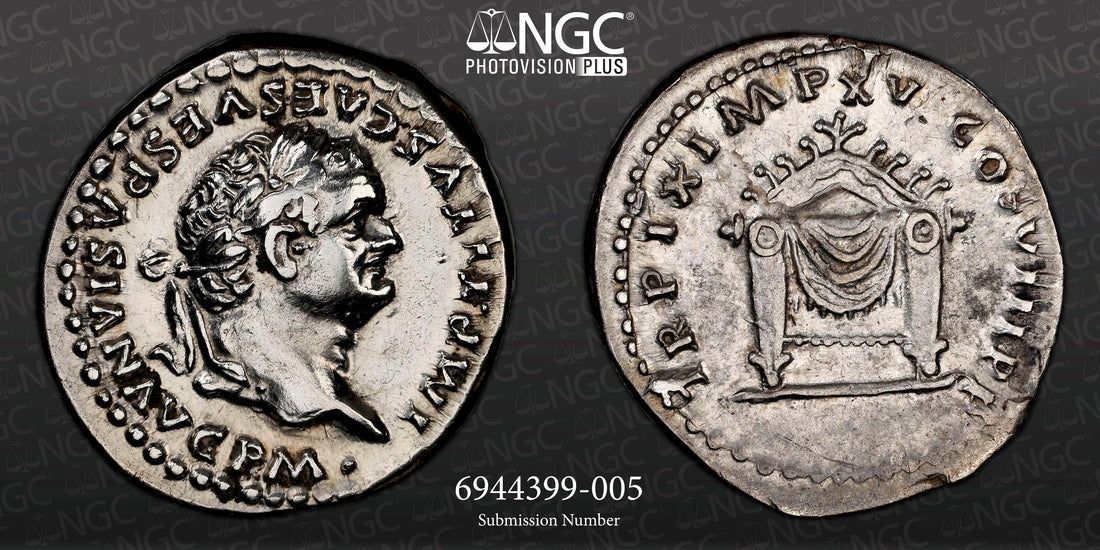
Titus Denarius (79-81 AD) - A Coin Symbolizing Power, Prosperity, and Roman Legacy
Share
Titus’s reign, though short (79-81 AD), was notable for several significant events. Perhaps most famously, it was during his rule that the eruption of Mount Vesuvius in 79 AD occurred, which destroyed the cities of Pompeii, Herculaneum, and Stabiae. Titus was praised for his swift and compassionate response to the disaster, sending relief to the affected regions. This benevolent image was crucial to his popularity, and it reflected his image as a ruler who cared for the welfare of his people. Additionally, Titus completed the construction of the Colosseum, one of the most enduring symbols of Roman engineering and entertainment. The massive amphitheatre, initially begun by his father, Vespasian, was inaugurated during Titus’s reign with a series of grand games. These events helped to cement his image as a ruler who could provide not only military success but also a cultural and social legacy.
The Obverse: Laureate Head of Titus
The obverse of the Titus denarius showcases a detailed portrait of the emperor. Titus is depicted wearing a laurel crown, facing right, with the inscription IMP. TITVS CAES VESPASIAN AVG P M surrounding the image.
The laurel wreath was a typical symbol of Roman imperial coins, denoting not just the emperor’s dignity but also his military triumphs. In this case, the laurel wreath links Titus to his victories and his status as a leader who has earned his place on Rome's imperial throne. The choice of a laureate head also suggests an emperor who is both noble and strong - traits that were highly valued by the Romans.
The inscription IMP. TITVS CAES VESPASIAN AVG P M translates to "Imperator Titus Caesar Vespasian Augustus Pontifex Maximus." The title Imperator highlights his role as a military commander. Caesar ties Titus to the Flavian dynasty, being the son of Emperor Vespasian, and Augustus denotes his position as the ruler of the Roman Empire. Additionally, Pontifex Maximus marks Titus as the chief priest of Roman religion, underscoring the emperor’s role as not just a political leader, but a religious one as well.
This carefully constructed image on the obverse of the coin is a clear message that Titus was both a military victor and a pious ruler, fulfilling his duty to the empire in both secular and religious realms.
The Reverse: The Throne with Grain Ears
On the reverse of the coin, we find a throne with a round back, draped in cloth, and decorated with ears of grain. The inscription TR P IX IMP XV COS VIII P P accompanies this image.
The throne depicted here is more than just a piece of furniture. It represents the emperor’s seat of power - the very foundation of Roman authority. The round back of the throne suggests not only comfort but also stability and dignity, reflecting the emperor’s position as a steady and secure ruler.
The ears of grain adorning the seat of the throne are an essential symbol of abundance and prosperity. Grain was crucial to Rome’s economy and its people’s well-being, and the emperor was often seen as the provider of sustenance. By including this imagery, the coin suggests that Titus was a ruler who ensured the empire’s prosperity and food security. The grain also evokes the emperor’s role in sustaining the Roman population, which was critical to the peace and stability of the empire. During times of crisis, such as famines, grain distribution was one of the emperor’s primary responsibilities.
The drapery on the seat enhances the regal nature of the throne, emphasizing the emperor’s dignity and authority. The throne, decorated with symbols of abundance, speaks to the emperor’s role in bringing stability and prosperity to Rome.
Political and Military Titles
The inscription on the reverse of the coin, TR P IX IMP XV COS VIII P P, reflects Titus's various titles and honours, which serve to further legitimize his authority and position.
- TR P IX refers to Titus’s ninth year as Tribunicia Potestas (tribunician power), a title that granted him the ability to veto legislation and protect the interests of the Roman people.
- IMP XV refers to his fifteenth acclamation as Imperator, a title given to victorious military commanders. This underscores Titus’s military achievements and his leadership in battle.
- COS VIII marks Titus’s eighth term as consul, an important political office in the Roman Republic that continued to be prestigious during the Empire.
- P P stands for Pater Patriae (Father of the Fatherland), a title that reflects Titus’s role as the protector of the Roman state and its people.
These titles were not merely ceremonial; they were tools that affirmed Titus’s power and justified his rule in the eyes of the Roman people.
Propaganda and Public Image
Roman coins were a form of imperial propaganda, designed to present a carefully constructed image of the emperor. Through the iconography of the Titus denarius, the emperor communicated his role as both a military leader and a provider for the Roman people. The throne and grain on the reverse emphasize his responsibility to ensure the prosperity and well-being of the empire, while the laureate portrait on the obverse underlines his military authority and divine favour.
The Titus denarius, like many Roman coins, functioned as both a piece of currency and a tool for political messaging. These coins were used to reinforce the emperor’s legitimacy, shape public perception, and maintain control over the empire.
A Coin of Power and Prosperity
The Titus denarius minted between 79-81 AD is a powerful symbol of the emperor’s reign and his contributions to Rome. The coin’s imagery of the throne and grain speaks to his role as a provider of peace and prosperity, while the laurel wreath and political titles affirm his authority as a military leader and emperor. In a reign marked by both natural disaster and monumental achievement, the denarius serves as a reminder of Titus’s efforts to bring stability and prosperity to the empire, leaving behind a lasting legacy for future generations. Whether for its artistic design or its political symbolism, the Titus denarius remains an enduring example of the power of Roman coinage in shaping imperial history.
